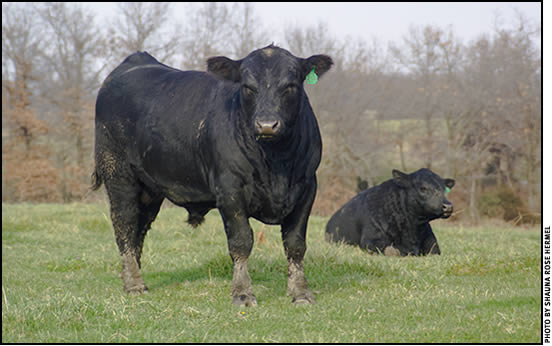Natural-service Bull
Performance and Production
Natural-service breeding remains a dominant management practice among U.S. cow-calf producers — especially in commercial herds. Particularly in western range areas, producers often manage large groups of cows in large multi-sire pastures. Even though a battery of bulls shares the work, producers can determine sires of individual calves through DNA testing. Researchers using parentage testing have found that bulls in a common breeding pasture certainly don’t share the work equally.
As a member of University of California–Davis (UC–Davis) Extension personnel, Dan Drake has been involved with paternity and performance research showing that some bulls are overachievers and others are slackers. Drake shared what research suggests regarding how bulls really affect ranch economics. Read more.

Kurt Kangas
Association Perspective
How do you track improvement?
For the commercial producer, the quickest way to make herd improvements is by purchasing a good bull, but without maintaining accurate records on the cow herd, how can improvement be tracked? Using the sale price of calves is a measure often used, but it is possible to collect other information on your calves to truly evaluate your cow herd.
Implementing a tagging system for the cow herd is a good first step to collect more information on the herd. Being able to accurately track and correlate calf information back to the dam can give the producer insights to how individual cows are performing within the herd. Collection of birth and weaning weights of calves, along with other phenotypic information, may add time to a day, but it could save money in the long run by identifying poorer-performing cows quicker. Read more.
Economically Relevant Traits and Selection Indexes
Time has proven expected progeny difference (EPD) values to be effective for selection of genetically superior beef cattle. Based on the assumption that more information about more traits would help to better characterize the genetic merit of potential breeding animals, the number of traits for which EPDs are calculated continued to grow. However, the multitude of EPD values and the volume of performance and pedigree information provided can be confusing to seedstock buyers.
“There can be too much information, causing us to throw up our hands,” said Colorado State University geneticist Mark Enns, addressing the Range Beef Cattle Symposium hosted Dec. 3-5, in Rapid City, S.D. Enns said the concept of economically relevant traits (ERTs) and selection indexes can help producers reduce the amount of information needed to make effective selection decisions. Read more.
 Join Us in Kansas City in 2014
Join Us in Kansas City in 2014
The first-ever ‘Angus Means Business’ National Convention & Trade Show returns
to the roots of the Angus business.
Kansas City is steeped in Angus history.
It’s a city that marks a threshold between east and west, north and south — a point of convergence for two great rivers, frontier trails, the railroads and the superhighways.
It opened the gate to westward expansion and witnessed the sweeping changes of history — the plow busting open the prairie, the expansion of farming and ranching, the green revolution that continues to feed the world.
This is where it all began — and it’s altogether fitting that Angus return to Kansas City, to celebrate its heritage, to set the course for the future.
The 2014 Angus Means Business National Convention & Trade Show will welcome the thought leaders of the cattle business and feature an industry-leading trade show, where agriculture’s top companies will display new products and services. Read more.
Farm Bureau Approves
Strategic Action Plan for 2014
Board approves plan for organization’s focus.
Following the delegate session of the American Farm Bureau Federation (AFBF) 95th Annual Convention, which wrapped up Jan. 15 in San Antonio, the organization’s board of directors met to set AFBF’s strategic action plan to address public policy issues for 2014.
The board-approved plan includes focusing the organization’s attention on the following key issues: ag labor reform, support for renewable fuels, support for biotechnology, protecting farmers’ interests in regard to new technology systems and data compilation, opposition to expanded federal jurisdiction under the Clean Water Act, and protecting farmer and rancher interest regarding fiscal policy and tax reform issues. Read more.
What’s Inside …
In this January edition of the Angus Beef Bulletin EXTRA, you'll find valuable articles devoted to the management, marketing, and health and nutrition of your beef enterprise. Select from the tabs at the top of the page to access this month's entire offering by category. A few select features include:
- Calf Survival in the Cold
- New Year’s Resolutions for Improved Performance
- Wind Chill Affects Cattle
- Late-winter Lice Control
- Selling a Premium Beef Product to Informed Consumers
- The Source: To tag or not to tag, that is the question.
News Briefs …
The American Angus Association and its subsidiaries generate a wealth of information to keep members and affiliates informed of what's happening within the industry as well as with the programs and services they offer. Click here for easy access to the newsrooms of the American Angus Association and Certified Angus Beef LLC and the Angus Journal Daily archive recently made available in the API Virtual Library.
RMEF Opposes Lawsuit
over Idaho Wolf Management
Groups express need for management of wolf populations in Idaho.
The Rocky Mountain Elk Foundation (RMEF) stands shoulder-to-shoulder with the Idaho Fish and Game Department (IDFG) in opposition to a lawsuit aimed at stopping the management of wolves in the Frank Church-River of No Return Wilderness.
“There is nothing illegal about this management activity,” said David Allen, RMEF president and CEO. “It clearly falls within the guidelines of Idaho’s federally approved wolf management plan.”
IDFG hired a hunter in late 2013 to track and kill wolves from two packs in central Idaho after determining wolf predation is a major factor preventing ailing elk populations in the area from recovering. Read more.
![]()
Hypothermia and Older Adults
Tips for staying safe in cold weather.
Frigid weather can pose special risks to older adults. The National Institute on Aging (NIA), part of the National Institutes of Health (NIH), has some advice for helping older people avoid hypothermia — when the body gets too cold — during cold weather.
Hypothermia is generally defined as having a core body temperature of 95° F or lower and can occur when the outside environment gets too cold or the body’s heat production decreases. Older adults are especially vulnerable to hypothermia because their bodies’ response to cold can be diminished by underlying medical conditions such as diabetes and by use of some medicines, including over-the-counter cold remedies. Hypothermia can develop in older adults after relatively short exposure to cold weather or even a small drop in temperature. Read more.
[Click here to go to the top of the page.]






